ASA围术期急性疼痛管理指南
- 格式:pdf
- 大小:761.05 KB
- 文档页数:26

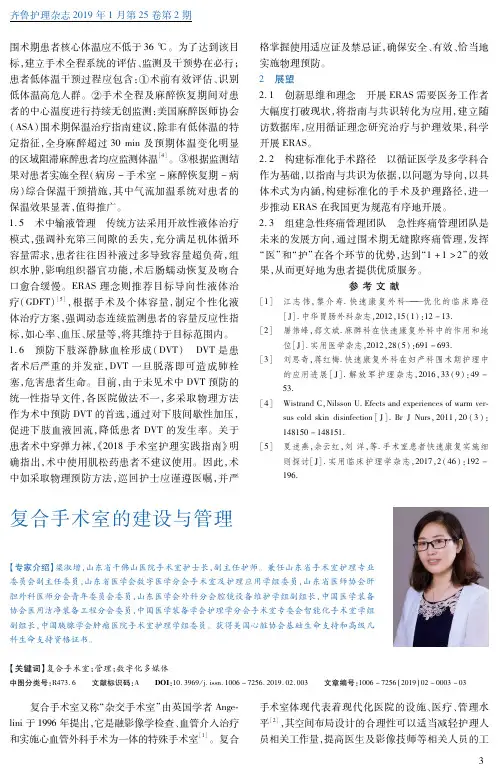
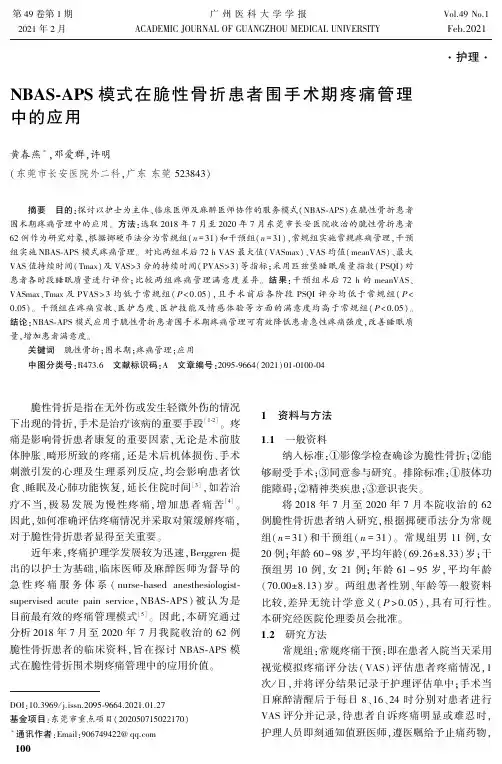
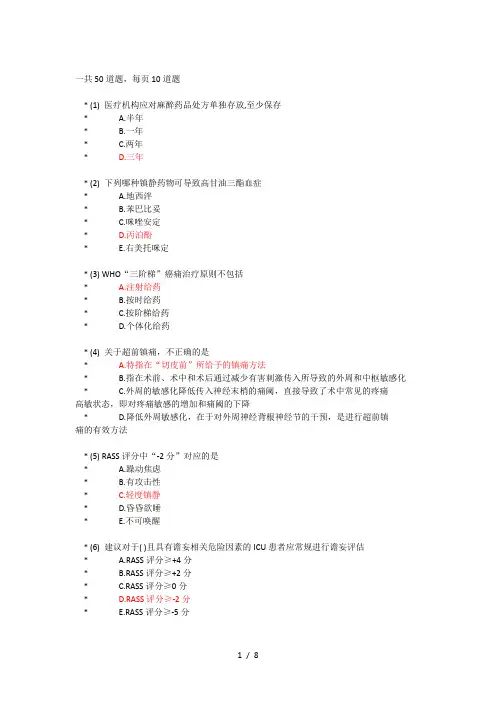
一共50道题,每页10道题* (1) 医疗机构应对麻醉药品处方单独存放,至少保存* A.半年* B.一年* C.两年* D.三年* (2) 下列哪种镇静药物可导致高甘油三酯血症* A.地西泮* B.苯巴比妥* C.咪唑安定* D.丙泊酚* E.右美托咪定* (3) WHO“三阶梯”癌痛治疗原则不包括* A.注射给药* B.按时给药* C.按阶梯给药* D.个体化给药* (4) 关于超前镇痛,不正确的是* A.特指在“切皮前”所给予的镇痛方法* B.指在术前、术中和术后通过减少有害刺激传入所导致的外周和中枢敏感化* C.外周的敏感化降低传入神经末梢的痛阈,直接导致了术中常见的疼痛高敏状态,即对疼痛敏感的增加和痛阈的下降* D.降低外周敏感化,在于对外周神经背根神经节的干预,是进行超前镇痛的有效方法* (5) RASS评分中“-2分”对应的是* A.躁动焦虑* B.有攻击性* C.轻度镇静* D.昏昏欲睡* E.不可唤醒* (6) 建议对于( )且具有谵妄相关危险因素的ICU患者应常规进行谵妄评估* A.RASS评分≥+4分* B.RASS评分≥+2分* C.RASS评分≥0分* D.RASS评分≥-2分* E.RASS评分≥-5分* (7) 关于阿片类药物不良反应的说法错误的是* A.阿片类药物大多数不良反应是暂时性的,也是可以耐受的* B.常见于用药初期或过量用药时* C.一旦出现不良反应就立即停药或换药* D.应采取必要的预防措施* (8) 对于老年人、或ASAⅢ级患者推荐使用的液体管理策略* A.非限制性补液* B.限制性补液* C.目标导向液体治疗* D.生理需要量+失血量* (9) 对于癌痛病人,阿片类药物推荐哪个用药途径* A.口服给药* B.注射给药* C.舌下给药* D.直肠给药* (10) 关于阿片类药物是否可以用于肺癌患者疼痛的治疗,下列说法中错误的是* A.阿片类药物引起的呼吸抑制是对呼吸中枢抑制的副作用所致,阿片类药本身不会加重肺部病变* B.阿片类药对呼吸中枢抑制的副作用, 一般仅发生在用药过量时或肾功能不全导致药物蓄积时,临床实践证明此药可以安全有效缓解肺癌患者的疼痛* C.肺癌疼痛患者使用阿片类药物镇痛时,也一定要遵循用药规X* D.阿片类药具有呼吸抑制的副作用,因此不能用于肺癌患者疼痛的治疗* (11) 疼痛治疗的一般原则中,以下哪项不正确* A.对轻、中度疼痛, 一般采用针灸或解热镇痛药或物理疗法止痛即可。
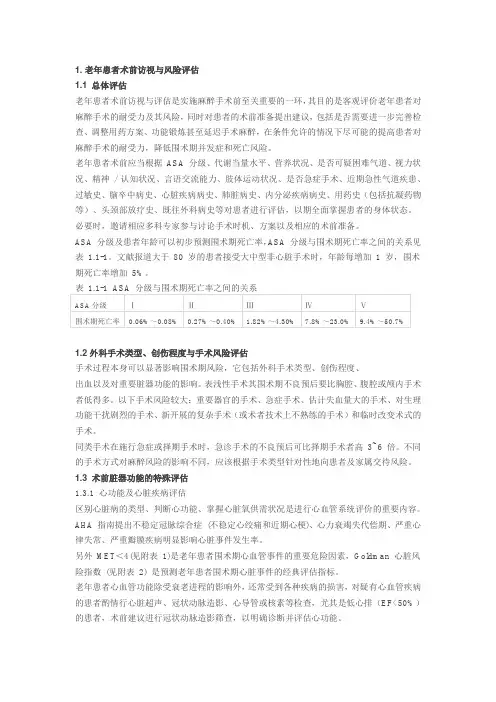
1.2 外科手术类型、创伤程度与手术风险评估手术过程本身可以显著影响围术期风险,它包括外科手术类型、创伤程度、出血以及对重要脏器功能的影响。
表浅性手术其围术期不良预后要比胸腔、腹腔或颅内手术者低得多。
以下手术风险较大:重要器官的手术、急症手术、估计失血量大的手术、对生理功能干扰剧烈的手术、新开展的复杂手术(或术者技术上不熟练的手术)和临时改变术式的手术。
同类手术在施行急症或择期手术时,急诊手术的不良预后可比择期手术者高3~6 倍。
不同的手术方式对麻醉风险的影响不同,应该根据手术类型针对性地向患者及家属交待风险。
1.3 术前脏器功能的特殊评估1.3.1 心功能及心脏疾病评估区别心脏病的类型、判断心功能、掌握心脏氧供需状况是进行心血管系统评价的重要内容。
AHA 指南提出不稳定冠脉综合症(不稳定心绞痛和近期心梗)、心力衰竭失代偿期、严重心律失常、严重瓣膜疾病明显影响心脏事件发生率。
另外MET<4(见附表1)是老年患者围术期心血管事件的重要危险因素,Goldman 心脏风险指数(见附表2) 是预测老年患者围术期心脏事件的经典评估指标。
老年患者心血管功能除受衰老进程的影响外,还常受到各种疾病的损害,对疑有心血管疾病的患者酌情行心脏超声、冠状动脉造影、心导管或核素等检查,尤其是低心排(EF<50%)的患者,术前建议进行冠状动脉造影筛查,以明确诊断并评估心功能。
对于高血压病患者宜行动态血压监测,检查眼底并明确有无继发心、脑、肾并发症及其损害程度。
对心率失常或心肌缺血患者应行动态心电图检查。
室壁瘤的患者,术前应该根据超声检查筛查是否真性室壁瘤。
另外应根据AHA 指南对合并有心脏病的患者进行必要的处理。
改良心脏风险指数(RCRI)(见附表3) 简单明了,在老年患者术后重大心血管事件的预测中具有重要作用,其内容包括:⑴高风险手术;⑵心力衰竭病史;⑶缺血性心脏病史;⑷脑血管疾病史;⑸需要胰岛素治疗的糖尿病;⑹血清肌酐浓度>2.0mg/dL。
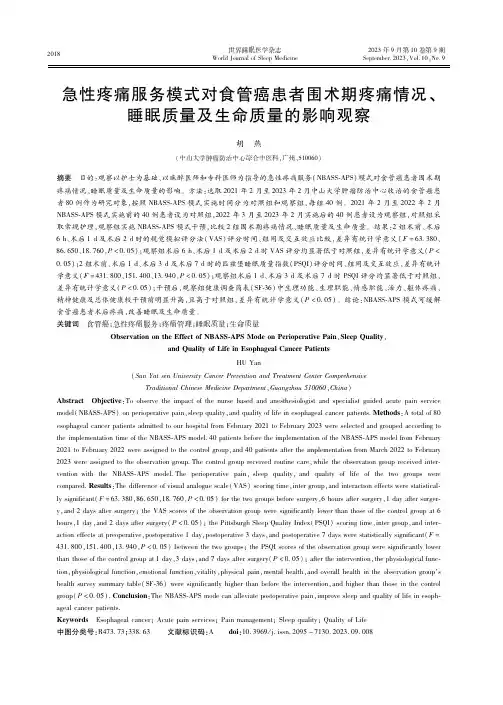
2018 世界睡眠医学杂志WorldJournalofSleepMedicine2023年9月第10卷第9期September.2023,Vol.10,No.9急性疼痛服务模式对食管癌患者围术期疼痛情况、睡眠质量及生命质量的影响观察胡 燕(中山大学肿瘤防治中心综合中医科,广州,510060)摘要 目的:观察以护士为基础、以麻醉医师和专科医师为指导的急性疼痛服务(NBASS APS)模式对食管癌患者围术期疼痛情况、睡眠质量及生命质量的影响。
方法:选取2021年2月至2023年2月中山大学肿瘤防治中心收治的食管癌患者80例作为研究对象,按照NBASS APS模式实施时间分为对照组和观察组,每组40例。
2021年2月至2022年2月NBASS APS模式实施前的40例患者设为对照组,2022年3月至2023年2月实施后的40例患者设为观察组,对照组采取常规护理,观察组实施NBASS APS模式干预,比较2组围术期疼痛情况、睡眠质量及生命质量。
结果:2组术前、术后6h、术后1d及术后2d时的视觉模拟评分法(VAS)评分时间、组间及交互效应比较,差异有统计学意义(F=63 380、86 650、18 760,P<0 05);观察组术后6h、术后1d及术后2d时VAS评分均显著低于对照组,差异有统计学意义(P<0 05);2组术前、术后1d、术后3d及术后7d时的匹兹堡睡眠质量指数(PSQI)评分时间、组间及交互效应,差异有统计学意义(F=431 800、151 400、13 940,P<0 05);观察组术后1d、术后3d及术后7d时PSQI评分均显著低于对照组,差异有统计学意义(P<0 05);干预后,观察组健康调查简表(SF 36)中生理功能、生理职能、情感职能、活力、躯体疼痛、精神健康及总体健康较干预前明显升高,且高于对照组,差异有统计学意义(P<0 05)。
结论:NBASS APS模式可缓解食管癌患者术后疼痛,改善睡眠及生命质量。
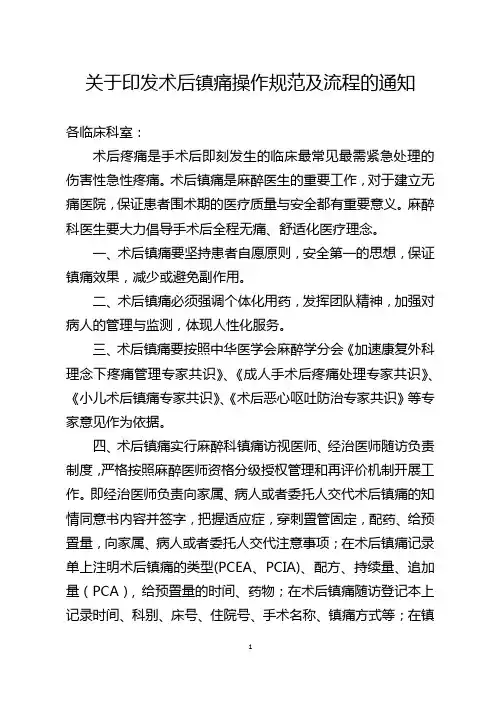
关于印发术后镇痛操作规范及流程的通知各临床科室:术后疼痛是手术后即刻发生的临床最常见最需紧急处理的伤害性急性疼痛。
术后镇痛是麻醉医生的重要工作,对于建立无痛医院,保证患者围术期的医疗质量与安全都有重要意义。
麻醉科医生要大力倡导手术后全程无痛、舒适化医疗理念。
一、术后镇痛要坚持患者自愿原则,安全第一的思想,保证镇痛效果,减少或避免副作用。
二、术后镇痛必须强调个体化用药,发挥团队精神,加强对病人的管理与监测,体现人性化服务。
三、术后镇痛要按照中华医学会麻醉学分会《加速康复外科理念下疼痛管理专家共识》、《成人手术后疼痛处理专家共识》、《小儿术后镇痛专家共识》、《术后恶心呕吐防治专家共识》等专家意见作为依据。
四、术后镇痛实行麻醉科镇痛访视医师、经治医师随访负责制度,严格按照麻醉医师资格分级授权管理和再评价机制开展工作。
即经治医师负责向家属、病人或者委托人交代术后镇痛的知情同意书内容并签字,把握适应症,穿刺置管固定,配药、给预置量,向家属、病人或者委托人交代注意事项;在术后镇痛记录单上注明术后镇痛的类型(PCEA、PCIA)、配方、持续量、追加量(PCA), 给预置量的时间、药物;在术后镇痛随访登记本上记录时间、科别、床号、住院号、手术名称、镇痛方式等;在镇痛泵上注明患者姓名、性别、科别、床号、住院号、药物、术后镇痛的类型(PCEA、PCIA)等。
五、轮班麻醉医师负责科室全部术后镇痛病人的随访,包括加药、处理副作用和或并发症、拔泵等,评估镇痛药物效果、药量及副作用,负责与病人所在科室医生沟通交流等等;确保每天访视次数及访视质量,麻醉科常规每天两次访视,其中麻醉科医师负责每日早晨晨会交班后做晨访视并在第二天晨会报告科室术后镇痛患者情况、如有特殊情况全科讨论,每日下午下班前主管麻醉医师须再次访视病人,如遇特殊情况需向值班医生交班增加随访观察次数。
术后镇痛病人在全天出现有需要解决的问题访视医师随时处理。
术后镇痛经治医师对该病人所做的工作负责并承担责任。

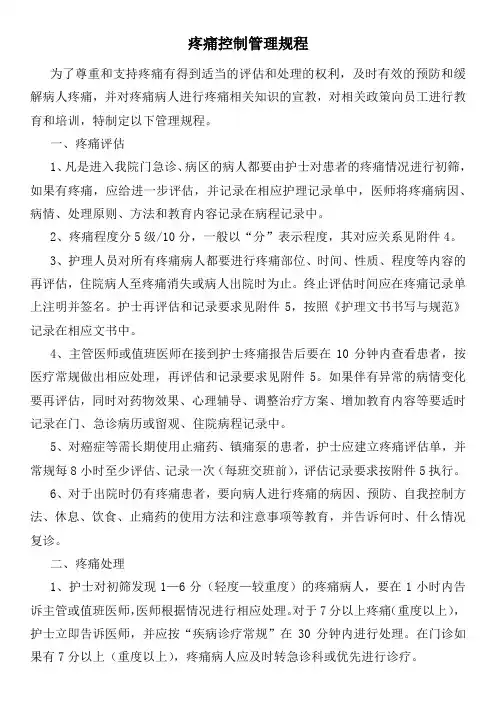
疼痛控制管理规程为了尊重和支持疼痛有得到适当的评估和处理的权利,及时有效的预防和缓解病人疼痛,并对疼痛病人进行疼痛相关知识的宣教,对相关政策向员工进行教育和培训,特制定以下管理规程。
一、疼痛评估1、凡是进入我院门急诊、病区的病人都要由护士对患者的疼痛情况进行初筛,如果有疼痛,应给进一步评估,并记录在相应护理记录单中,医师将疼痛病因、病情、处理原则、方法和教育内容记录在病程记录中。
2、疼痛程度分5级/10分,一般以“分”表示程度,其对应关系见附件4。
3、护理人员对所有疼痛病人都要进行疼痛部位、时间、性质、程度等内容的再评估,住院病人至疼痛消失或病人出院时为止。
终止评估时间应在疼痛记录单上注明并签名。
护士再评估和记录要求见附件5,按照《护理文书书写与规范》记录在相应文书中。
4、主管医师或值班医师在接到护士疼痛报告后要在10分钟内查看患者,按医疗常规做出相应处理,再评估和记录要求见附件5。
如果伴有异常的病情变化要再评估,同时对药物效果、心理辅导、调整治疗方案、增加教育内容等要适时记录在门、急诊病历或留观、住院病程记录中。
5、对癌症等需长期使用止痛药、镇痛泵的患者,护士应建立疼痛评估单,并常规每8小时至少评估、记录一次(每班交班前),评估记录要求按附件5执行。
6、对于出院时仍有疼痛患者,要向病人进行疼痛的病因、预防、自我控制方法、休息、饮食、止痛药的使用方法和注意事项等教育,并告诉何时、什么情况复诊。
二、疼痛处理1、护士对初筛发现1—6分(轻度—较重度)的疼痛病人,要在1小时内告诉主管或值班医师,医师根据情况进行相应处理。
对于7分以上疼痛(重度以上),护士立即告诉医师,并应按“疾病诊疗常规”在30分钟内进行处理。
在门诊如果有7分以上(重度以上),疼痛病人应及时转急诊科或优先进行诊疗。
2、不予止痛剂治疗:疼痛轻微可以忍受者;拒绝止痛治疗者;诊断不明、止痛治疗后可能延误病情者。
3、止痛治疗:临床医师根据病人情况在不违背医疗原则的前提下及时足量使用止痛剂缓解控制疼痛。
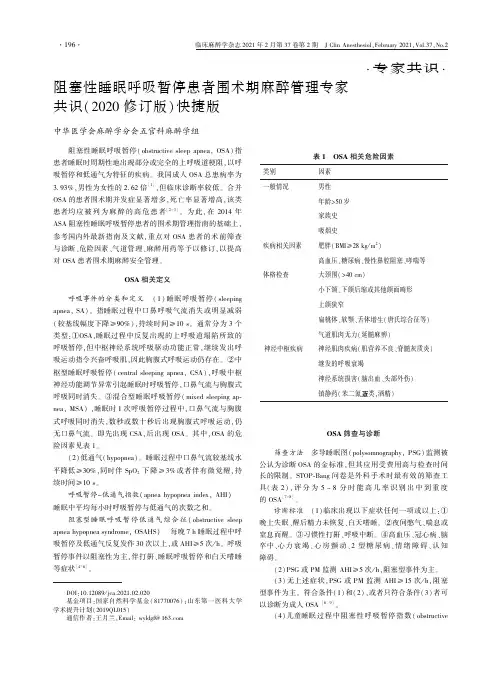
㊃专家共识㊃阻塞性睡眠呼吸暂停患者围术期麻醉管理专家共识(2020修订版)快捷版中华医学会麻醉学分会五官科麻醉学组㊀㊀DOI:10.12089/jca.2021.02.020基金项目:国家自然科学基金(81770076);山东第一医科大学学术提升计划(2019QL015)通信作者:王月兰,Email:wyldgf@163.com㊀㊀阻塞性睡眠呼吸暂停(obstructivesleepapnea,OSA)指患者睡眠时周期性地出现部分或完全的上呼吸道梗阻,以呼吸暂停和低通气为特征的疾病㊂我国成人OSA总患病率为3 93%,男性为女性的2 62倍[1],但临床诊断率较低㊂合并OSA的患者围术期并发症显著增多,死亡率显著增高,该类患者均应被列为麻醉的高危患者[2-3]㊂为此,在2014年ASA阻塞性睡眠呼吸暂停患者的围术期管理指南的基础上,参考国内外最新指南及文献,重点对OSA患者的术前筛查与诊断㊁危险因素㊁气道管理㊁麻醉用药等予以修订,以提高对OSA患者围术期麻醉安全管理㊂OSA相关定义呼吸事件的分类和定义㊀(1)睡眠呼吸暂停(sleepingapnea,SA)㊂指睡眠过程中口鼻呼吸气流消失或明显减弱(较基线幅度下降ȡ90%),持续时间ȡ10s㊂通常分为3个类型:①OSA,睡眠过程中反复出现的上呼吸道塌陷所致的呼吸暂停,但中枢神经系统呼吸驱动功能正常,继续发出呼吸运动指令兴奋呼吸肌,因此胸腹式呼吸运动仍存在㊂②中枢型睡眠呼吸暂停(centralsleepingapnea,CSA),呼吸中枢神经功能调节异常引起睡眠时呼吸暂停,口鼻气流与胸腹式呼吸同时消失㊂③混合型睡眠呼吸暂停(mixedsleepingap⁃nea,MSA),睡眠时1次呼吸暂停过程中,口鼻气流与胸腹式呼吸同时消失,数秒或数十秒后出现胸腹式呼吸运动,仍无口鼻气流㊂即先出现CSA,后出现OSA㊂其中,OSA的危险因素见表1㊂(2)低通气(hypopnea)㊂睡眠过程中口鼻气流较基线水平降低ȡ30%,同时伴SpO2下降ȡ3%或者伴有微觉醒,持续时间ȡ10s㊂呼吸暂停-低通气指数(apneahypopneaindex,AHI)㊀睡眠中平均每小时呼吸暂停与低通气的次数之和㊂阻塞型睡眠呼吸暂停低通气综合征(obstructivesleepapneahypopneasyndrome,OSAHS)㊀每晚7h睡眠过程中呼吸暂停及低通气反复发作30次以上,或AHIȡ5次/h㊂呼吸暂停事件以阻塞性为主,伴打鼾㊁睡眠呼吸暂停和白天嗜睡等症状[4-6]㊂表1㊀OSA相关危险因素类别因素一般情况男性年龄>50岁家族史吸烟史疾病相关因素肥胖(BMIȡ28kg/m2)高血压㊁糖尿病㊁慢性鼻腔阻塞㊁哮喘等体格检查大颈围(>40cm)小下颌㊁下颌后缩或其他颌面畸形上颌狭窄扁桃体㊁软颚㊁舌体增生(唐氏综合征等)气道肌肉无力(延髓麻痹)神经中枢疾病神经肌肉疾病(肌营养不良㊁脊髓灰质炎)继发的呼吸衰竭神经系统损害(脑出血㊁头部外伤)镇静药(苯二氮类,酒精)OSA筛查与诊断筛查方法㊀多导睡眠图(polysomnography,PSG)监测被公认为诊断OSA的金标准,但其应用受费用高与检查时间长的限制㊂STOP⁃Bang问卷是外科手术时最有效的筛查工具(表2),评分为5 8分时能高几率识别出中到重度的OSA[7-8]㊂诊断标准㊀(1)临床出现以下症状任何一项或以上:①晚上失眠㊁醒后精力未恢复㊁白天嗜睡㊂②夜间憋气㊁喘息或窒息而醒㊂③习惯性打鼾㊁呼吸中断㊂④高血压㊁冠心病㊁脑卒中㊁心力衰竭㊁心房颤动㊁2型糖尿病㊁情绪障碍㊁认知障碍㊂(2)PSG或PM监测AHIȡ5次/h,阻塞型事件为主㊂(3)无上述症状,PSG或PM监测AHIȡ15次/h,阻塞型事件为主㊂符合条件(1)和(2),或者只符合条件(3)者可以诊断为成人OSA[6,9]㊂(4)儿童睡眠过程中阻塞性呼吸暂停指数(obstructive表2㊀STOP⁃Bang问卷(中文版)问题否(0分)是(1分)S=打鼾:是否大声打鼾(比讲话声音大,或者关上门也可以听到)?T=疲劳:白天是否感觉累,困倦或者想睡觉?O=观察:是否有人观察到睡眠中呼吸暂停?P=血压:是否高血压?B=BMI:BMI是否大于35kg/m2?A=年龄:年龄是否超过50岁?N=颈围:颈围是否大于40cm?G=男性:是否男性?㊀㊀注:0 2分,低风险;3 4分,中度风险;5 8分,高风险apneaindex,OAI)ȡ1次/h或AHIȡ5次/h,每次持续时间ȡ2个呼吸周期;最低SpO2<92%;儿童满足以上两者即可诊断OSA[10](表3 4)㊂表3㊀成人OSA病情程度判断依据[4-6]程度AHI(次/h)a最低SpO2(%)b无<5>90轻度ȡ5且ɤ15ȡ85且ɤ90中度>15且ɤ30ȡ80且<85重度>30<80㊀㊀注:a,主要依据;b,辅助依据表4㊀儿童OSA病情程度判断依据[10]程度AHI或OAI(次/h)最低SpO2(%)无<5或0>91轻度5 10或1 585 91中度11 20或6 1075 84重度>20或>10<75OSA患者术前评估和准备术前评估㊀(1)OSA严重程度及围术期风险评估㊂OSA围术期风险评分系统见表5㊂需要注意的是,此系统未经临表5㊀OSA围术期风险评分系统[11]指标得分A:OSA严重程度(如无法进行睡眠研究则参考临床症状)(0 3分)㊀无0㊀轻度1㊀中度2㊀重度3B:手术和麻醉因素(0 3分)㊀局部或周围神经阻滞麻醉下的浅表手术,无镇静药0㊀中度镇静或全身麻醉浅表手术,椎管内麻醉(不超过中度镇静)外周手术1㊀全身麻醉外周手术,中度镇静的气道手术2㊀全身麻醉大手术或气道手术3C:术后阿片类药物使用(0 3分)㊀不需要0㊀低剂量口服阿片类药物1㊀大剂量口服㊁肠外或神经轴性阿片类药物3总分:A项目分值+B或C项目中较高分值者(0 6分)床验证,仅作为指导和临床判断,应用于评估个别患者的风险㊂如患者术前已有持续气道正压通气(CPAP)或无创正压通气(NIPPV),且在术后将继续使用,则可减去1分;如轻或中度OSA患者静息时PaCO2>50mmHg,则应增加1分;评分为4分的OSA患者引发围术期风险增加;评分为5分以上者则围术期风险显著增加㊂(2)困难气道评估㊂①详细询问气道方面的病史;②颜面部畸形,如小下颌畸形㊁下颌后缩畸形㊁舌骨位置异常等;③上呼吸道解剖异常,如口咽腔狭小㊁扁桃体腺样体肥大㊁舌体肥大等;④结合Mallampati分级㊁直接或间接喉镜检查㊁影像学检查等结果综合判断[12-13]㊂(3)重要器官功能评估㊂对心脑血管系统㊁呼吸系统和肾脏功能等受累的严重程度进行评估,同时进行相应的治疗,使受损器官达到较好的功能状态[11,14]㊂(4)日间与门诊手术评估㊂在计划进行手术之前,应评估患者是否适合日间或门诊手术,其评估因素包括:①睡眠呼吸暂停状态,②上呼吸道解剖和生理异常程度,③并存疾病状态,④手术种类,⑤麻醉类型,⑥术后阿片类药物的需要程度,⑦患者年龄,⑧出院后观察的可靠程度,⑨门诊设施是否具备呼吸管理及紧急气道处理条件[11]㊂术前准备㊀(1)患者准备㊂术前准备旨在改善或优化OSA患者围术期的身体状况,包括术前CPAP或NIPPV治疗,下颌前移矫正器或口腔矫治器及减肥等措施[14-15]㊂(2)麻醉物品与监测设备㊂术前必须准备好完成困难插管的各种导管与设备,备好麻醉机㊁具有SpO2㊁BP㊁ECG和PETCO2的监测仪,同时还应备有血气分析仪㊁转运呼吸机以及必要的血液动力学监测仪㊂OSA患者术中管理术中监测㊀主要包括呼吸功能㊁循环功能㊁麻醉深度及术中可能发生的并发症等,尤其在麻醉诱导和苏醒期㊂麻醉方法㊀如条件允许,区域阻滞可作为首选㊂区域阻滞包括局部麻醉㊁外周神经阻滞及椎管内麻醉㊂如需合并镇静,则镇静深度应控制在最小,且严密监测㊂对于手术创伤大㊁操作复杂㊁出血多㊁伴有大量体液丢失及转移的手术以及对患者呼吸㊁循环功能影响大的手术(如心㊁胸和神经外科手术),仍以选择气管内插管全身麻醉为宜,且全身麻醉复合神经阻滞可以改善预后[16-17]㊂气道管理㊀所有OSA患者均应考虑存在困难气道,实施麻醉诱导时,推荐患者取头高斜坡位,关于困难气道的处理请参阅困难气道管理指南[12-13]㊂(1)清醒镇静经鼻气管插管㊂主要包括患者准备㊁镇静镇痛和表面麻醉等几个环节:①需要充分的沟通取得患者积极配合;②评价鼻腔通畅情况,面罩吸氧,应选择患者感觉通气较好一侧的鼻腔施行此操作,如两侧通气相同则以左侧为首选;③静脉开放及用药,包括抗胆碱能药物(阿托品㊁盐酸戊乙奎醚等)㊁镇静药物(咪达唑仑㊁右美托咪定等)㊁镇痛药物(阿片类药物);④完善的表面麻醉(依次是鼻腔㊁口咽㊁声门和气管内)是顺利实施经鼻清醒气管插管的关键;⑤置入气管导管㊂(2)快速诱导经口/鼻气管插管㊂对行非OSA矫正手术㊁且无通气困难和插管困难的OSA患者,可行快速诱导经口或鼻腔气管插管㊂(3)快速诱导可视喉罩下气管插管㊂分预给氧㊁适度镇静和局部表麻后,可先置入可视喉罩,确保通气良好的情况下,再给予肌松药㊁镇痛药后经喉罩行气管插管[18]㊂(4)经鼻湿化快速吹氧通气交换技术(THRIVE)㊂THRIVE是在预充氧的基础上用于延长安全窒息时间的给氧方法,可显著改善氧合㊁延长安全窒息时间[19]㊂麻醉药物㊀麻醉药物如镇静药㊁安眠药㊁阿片类药物和肌松药加重气道的不稳定性,抑制中枢对低氧和高碳酸血症的敏感性,减弱呼吸肌功能,从而导致更频繁和严重的呼吸暂停,同时因手术应激㊁心血管反应等使接受大手术的患者面临较高风险㊂循环功能及内环境稳定管理㊀术中应控制一定麻醉深度㊁严密监测血压㊁心律㊁心电图ST-T改变等㊂定期检测动脉血气,了解有无CO2蓄积㊁电解质及酸碱平衡等变化,以确保组织氧合与灌注㊂OSA患者术后管理术后疼痛管理㊀采取不同作用机制的镇痛药物,多途径㊁多模式的镇痛方法更为安全可靠,主要包括非阿片类镇痛药㊁局麻药行区域性镇痛和使用长效局麻药或通过持续性外周神经阻滞㊂对需额外给予阿片类药物镇痛的患者,应使用最低有效剂量,并密切监测呼吸氧合变化㊂应尽量避免同时使用镇静剂,并备好各类拮抗药[20]㊂气道正压通气(PAP)治疗㊀对术前依从PAP治疗的OSA患者,建议术后采用PAP治疗㊂对未诊断为OSA或诊断为OSA但不依从或不耐受PAP的患者,建议在发生低氧血症㊁气道梗阻㊁呼吸暂停或通气不足时使用PAP治疗㊂PACU管理㊀OSA患者麻醉苏醒期管理重点为维持充足的氧合及气道通畅㊁合理判断拔管时机及防止相关并发症发生㊂多数患者在达到常规出PACU标准后还应再监测至少1h[21]㊂重症OSA患者,或轻中度OSA患者但具有明显困难气道表现㊁接受咽颚成型术或联合正颌外科手术以及手术过程不顺利的患者,术后可能出血或发生气道梗阻的患者,均需保留气管内导管㊂带管在ICU或PACU治疗,直至患者完全清醒,并确保无活动性出血㊁大量分泌物和上呼吸道水肿等情况,在侧卧位㊁半卧位或其他非仰卧位下拔管㊂拔管后若有可能,应保持半直立体位㊂病房管理㊀患者应持续监测SpO2和通气情况,尽可能脱离辅助供氧㊁避免仰卧位和镇痛药,并在睡眠期间维持PAP治疗㊂脱离高风险的标准:①对阿片类镇痛药和镇静药的需求低;②维持清晰的精神状态;③自由采取睡眠体位,睡眠时成功恢复PAP治疗或口腔矫正器治疗;④氧合充足,即在清醒和睡眠时,呼吸室内空气时SpO2>90%㊂专家组成人员名单负责人吴新民(北京大学第一医院麻醉科)王月兰[山东第一医科大学第一附属医院(山东省千佛山医院)麻醉与围术期医学科]执笔人王月兰[山东第一医科大学第一附属医院(山东省千佛山医院)麻醉与围术期医学科]孙永涛[山东第一医科大学第一附属医院(山东省千佛山医院)麻醉与围术期医学科]成员(按姓氏拼音顺序)于布为(上海交通大学医学院附属瑞金医院麻醉科)王古岩(首都医科大学附属北京同仁医院麻醉科)王焕亮(山东大学齐鲁医院麻醉科)邓小明(上海长海医院麻醉科)李天佐(首都医科大学附属北京世纪坛医院麻醉科)李文献(上海复旦大学附属眼耳鼻喉科医院麻醉科)黄宇光(北京协和医院麻醉科)薛张纲(上海复旦大学附属中山医院麻醉科)参考文献[1]㊀潘悦达,王东博,韩德民.我国成人阻塞性睡眠呼吸暂停低通气综合征患病率的Meta分析.医学信息,2019,32(7):73⁃77,81.[2]㊀CadbyG,McArdleN,BriffaT,etal.SeverityofOSAisanin⁃dependentpredictorofincidentatrialfibrillationhospitalizationinalargesleep⁃cliniccohort.Chest,2015,148(4):945⁃952.[3]㊀HirotsuC,Haba⁃RubioJ,TogeiroSM,etal.Obstructivesleepapnoeaasariskfactorforincidentmetabolicsyndrome:ajoinedEpisonoandHypnoLausprospectivecohortsstudy.EurRespirJ,2018,52(5):1801150.[4]㊀中华医学会呼吸病学分会睡眠呼吸障碍学组.阻塞性睡眠呼吸暂停低通气综合征诊治指南(2011年修订版).中华结核和呼吸杂志,2012,35(1):9⁃12.[5]㊀中国医师协会睡眠医学专业委员会.成人阻塞性睡眠呼吸暂停多学科诊疗指南.中华医学杂志,2018,98(24):1902⁃1914.[6]㊀中华医学会,中华医学会杂志社,中华医学会全科医学分会,等.成人阻塞性睡眠呼吸暂停基层诊疗指南(2018年).中华全科医师杂志,2019,18(1):21⁃29.[7]㊀ChungF,LiaoP,FarneyR.CorrelationbetweentheSTOP⁃Bangscoreandtheseverityofobstructivesleepapnea.Anesthesiology,2015,122(6):1436⁃1437.[8]㊀NagappaM,LiaoP,WongJ,etal.ValidationoftheSTOP⁃Bangquestionnaireasascreeningtoolforobstructivesleepapneaamongdifferentpopulations:asystematicreviewandmeta⁃analysis.PLoSOne,2015,10(12):e0143697.[9]㊀AmericanAcademyofSleepMedicine.Internationalclassificationofsleepdisordem.3rded.Darien:AmericanAcademyofSleepMedieine,2014.[10]㊀中华耳鼻咽喉头颈外科杂志编委会,中华医学会耳鼻咽喉科学分会.儿童阻塞性睡眠呼吸暂停低通气综合征诊疗指南草案(乌鲁木齐).中华耳鼻咽喉头颈外科杂志,2007,42(2):83⁃84.[11]㊀AmericanSocietyofAnesthesiologistsTaskForceonPerioperativeManagementofpatientswithobstructivesleepapnea.Practiceguidelinesfortheperioperativemanagementofpatientswithob⁃structivesleepapnea:anupdatedreportbytheAmericanSocietyofAnesthesiologistsTaskForceonPerioperativeManagementofpatientswithobstructivesleepapnea.Anesthesiology,2014,120(2):268⁃286.[12]㊀ApfelbaumJL,HagbergCA,CaplanRA,etal.Practiceguide⁃linesformanagementofthedifficultairway:anupdatedreportbytheAmericanSocietyofAnesthesiologistsTaskForceonManage⁃mentoftheDifficultAirway.Anesthesiology,2013,118(2):251⁃270.[13]㊀于布为,吴新民,左明章,等.困难气道管理指南.临床麻醉学杂志,2013,29(1):93⁃98.[14]㊀MutterTC,ChateauD,MoffattM,etal.Amatchedcohortstudyofpostoperativeoutcomesinobstructivesleepapnea:couldpre⁃operativediagnosisandtreatmentpreventcomplications.Anesthe⁃siology,2014,121(4):707⁃718.[15]㊀AbdelsattarZM,HendrenS,WongSL,etal.Theimpactofun⁃treatedobstructivesleepapneaoncardiopulmonarycomplicationsingeneralandvascularsurgery:acohortstudy.Sleep,2015,38(8):1205⁃1210.[16]㊀MemtsoudisSG,StundnerO,RasulR,etal.Sleepapneaandtotaljointarthroplastyundervarioustypesofanesthesia:apopu⁃lation⁃basedstudyofperioperativeoutcomes.RegAnesthPainMed,2013,38(4):274⁃281.[17]㊀NaqviSY,RabieiAH,MaltenfortMG,etal.Perioperativecom⁃plicationsinpatientswithsleepapneaundergoingtotaljointar⁃throplasty.JArthroplasty,2017,32(9):2680⁃2683.[18]㊀Gómez⁃RíosMÁ,Freire⁃VilaE,Casans⁃FrancésR,etal.TheTotaltrackTMvideolaryngealmask:anevaluationin300patients.Anaesthesia,2019,74(6):751⁃757.[19]㊀GustafssonIM,LodeniusÅ,TunelliJ,etal.Apnoeicoxygenationinadultsundergeneralanaesthesiausingtransnasalhumidifiedrapid⁃insufflationventilatoryexchange(THRIVE)⁃aphysiologicalstudy.BrJAnaesth,2017,118(4):610⁃617.[20]㊀ChungF,LiaoP,ElsaidH,etal.Factorsassociatedwithpost⁃operativeexacerbationofsleep⁃disorderedbreathing.Anesthesiol⁃ogy,2014,120(2):299⁃311.[21]㊀GaliB,WhalenFX,SchroederDR,etal.Identificationofpa⁃tientsatriskforpostoperativerespiratorycomplicationsusingapreoperativeobstructivesleepapneascreeningtoolandpostanes⁃thesiacareassessment.Anesthesiology,2009,110(4):869⁃877.(收稿日期:20200910)。

术后镇痛治疗管理规范与程序术后镇痛可以有效地减少病人的痛苦,对病人的术后恢复起到积极地帮住作用.术后镇痛管理主要是是病区使用镇痛泵的规范化管理问题,我院根据上级卫生部门及我院的实际情况制定本规范。
对镇痛泵的应用采取规范化管理,对护士参与手术后的疼痛管理提出了新的要求,即实施以护士为主体、麻醉师为督导的人性化管理.一、建立健全病区使用管理制度:指定病区1 名主管护师负责建立病区镇痛泵管理档案;建立病区镇痛泵使用登记本。
制定术后镇痛的专用登记表;表格内容包括病人的姓名、性别、年龄、身高、体重、住院号;麻醉方式、疾病诊断、镇痛途径,药液配方、镇痛时间、镇痛效果以及并发症等观察项目。
所有术后镇痛的病人都建立登记表,登记表的内容项目要认真填写完善,以备记录使用.二、建立术后疼痛病人管理工作流程:病人返回病房后护士首先与麻醉师严格交接班,了解手术方式、麻醉方法、PCA 泵药物配比情况、锁定时间、PCA 泵开放情况,护士告知病人及家属镇痛泵使用注意事项:严禁碰撞、挂起、坠地,一旦发生立即与护士联系;起床活动时镇痛泵低于穿刺部位;严禁在镇痛泵上连接液体以免药液稀释影响镇痛效果;不要频繁按压镇痛泵上的追加药物剂量按钮,评估病人麻醉恢复情况、疼痛强度,疼痛为中度时可按压镇痛泵追加镇痛药,观察镇痛效果,如效果不佳可与麻醉师联系。
护士严格按流程操作.三、加强护理人员的规范化培训:科内护士学习人文关怀及疼痛的控制理论;麻醉师讲解镇痛药、镇痛泵的应用过程以及异常事件的发生前兆和应对措施;对护士进行疼痛管理理论知识的培训,尤其是术后镇痛的新观点、新方法等。
四、加强镇痛治疗知识的普及:协调麻醉科工作取得医生的支持与共同参与,宣传术后镇痛可以给病人带来的好处及对疾病康复的有利因素,争取临床医生的理解与支持.对病房护士加强护理方面的培训,以便在临床护理工作中加强观察,及时反馈镇痛治疗过程出现的问题,全面提高病人的镇痛质量和满意度。
术后疼痛管理指南李硕北京大学人民医院疼痛作为第五大生命体征,已经受到越来越多的关注。
在外科的临床护理中,术后疼痛管理是一项十分重要的工作内容,此方面研究逐渐增加。
美国疼痛协会(American Pain Society,APS)和美国麻醉医师协会(American Society of Anesthesiologists,ASA)部分成员组成了一个多学科专家小组,该小组对术后疼痛管理的证据进行系统回顾后,于2016年2月发表了“术后疼痛管理指南”。
很实用的指南,接下来我们一起学习一下吧。
证据回顾表明,80%的术后患者会出现急性疼痛,其中75%的患者疼痛程度为中、重度,且只有不到一半的患者术后疼痛得到了适度的缓解。
虽然术后疼痛的控制现状不容乐观,但是许多围术期的干预与策略可以用来减轻和管理术后疼痛。
该指南中的推荐建议,包括术前教育、围术期疼痛管理计划,多模式镇痛,组织策略、转运与出院护理几部分。
具体如下:1.术前教育手术前可以通过面对面指导、书面材料、影像学资料等途径对患者进行术前教育,主要内容为围术期治疗相关知识、术后疼痛的评估和报告,及术后疼痛控制目标,鼓励患者及家属参与到疼痛管理当中。
对患儿及其照顾者同样需要进行术前教育,告知患者手术预后,向患儿父母讲解如何对儿童进行术后疼痛评估。
2.围术期疼痛管理计划疼痛管理计划因具体手术方式、部位不同而有差异,应结合患者的手术史、疼痛治疗史、药物耐受情况、认知状态、并发症及患者的意愿制定个体化的术后疼痛管理方案。
术前临床医生应充分评估患者合并疾病、慢性疼痛史、药物滥用史及既往术后治疗的原则和反应,从而指导围术期疼痛管理计划的制定。
3.疼痛评估最佳的疼痛管理需要反复进行疼痛评估,使用有效的疼痛评估工具,来观察术后疼痛治疗的反应并依此来调整治疗计划。
疼痛是病人内在的主观感受,自我描述是疼痛评估的原始依据,对不能进行自我描述的患者要使用疼痛行为测量工具或从照顾者获取信息。
SPECIAL ARTICLESPractice Guidelines for Acute Pain Management in the Perioperative SettingAn Updated Report by the American Society ofAnesthesiologists Task Force on Acute Pain ManagementPRACTICE Guidelines are systematically developed rec-ommendations that assist the practitioner and patient in making decisions about health care.These recommenda-tions may be adopted,modified,or rejected according to clinical needs and constraints and are not intended to replace local institutional policies.In addition,Practice Guidelines de-veloped by the American Society of Anesthesiologists (ASA)are not intended as standards or absolute requirements,and their use cannot guarantee any specific outcome.Practice Guidelines are subject to revision as warranted by the evolution of medical knowledge,technology,and practice.They provide basic rec-ommendations that are supported by a synthesis and analysis ofthe current literature,expert and practitioner opinion,open fo-rum commentary,and clinical feasibility data.This document updates the “Practice Guidelines for Acute Pain Management in the Perioperative Setting:An Updated Report by the American Society of Anesthesiolo-gists Task Force on Acute Pain Management,”adopted by the ASA in 2003and published in 2004.*MethodologyA.Definition of Acute Pain Management in the Perioperative SettingFor these Guidelines,acute pain is defined as pain that is present in a surgical patient after a procedure.Such pain may be the result of trauma from the procedure or procedure-related complications.Pain management in the perioperative setting refers to actions before,during,and after a procedureUpdated by the American Society of Anesthesiologists (ASA)Com-mittee on Standards and Practice Parameters,Jeffrey L.Apfelbaum,M.D.(Committee Chair),Chicago,Illinois;Michael A.Ashburn,M.D.,M.P.H.(Task Force Chair),Philadelphia,Pennsylvania;Richard T.Con-nis,Ph.D.,Woodinville,Washington;Tong J.Gan,M.D.,Durham,North Carolina;and David G.Nickinovich,Ph.D.,Bellevue,Washing-ton.The previous update was developed by the ASA Task Force on Acute Pain Management:Michael A.Ashburn,M.D.,M.P.H.(Chair),Salt Lake City,Utah;Robert A.Caplan,M.D.,Seattle,Washington;Daniel B.Carr,M.D.,Boston,Massachusetts;Richard T.Connis,Ph.D.,Woodinville,Washington;Brian Ginsberg,M.D.,Durham,North Car-olina;Carmen R.Green,M.D.,Ann Arbor,Michigan;Mark J.Lema,M.D.,Ph.D.,Buffalo,New York;David G.Nickinovich,Ph.D.,Belle-vue,Washington;and Linda Jo Rice,M.D.,St.Petersburg,Florida.Received from the American Society of Anesthesiologists,Park Ridge,Illinois.Submitted for publication October 20,2011.Accepted for publication October 20,2011.Supported by the American Society of Anesthesiologists and developed under the direction of the Committee on Standards and Practice Parameters,Jeffrey L.Apfelbaum,M.D.(Chair).Approved by the ASA House of Delegates on October 19,2011.A complete list of references used to develop these updated Guidelines,arranged alphabeti-cally by author,is available as Supplemental Digital Content 1,/ALN/A780.Address correspondence to the American Society of Anesthesi-ologists:520North Northwest Highway,Park Ridge,Illinois 60068-2573.These Practice Guidelines,as well as all published ASA Prac-tice Parameters,may be obtained at no cost through the Journal Web site,.*American Society of Anesthesiologists Task Force on Acute Pain Management:Practice guidelines for acute pain management in the perioperative setting:An updated report by the American Society of Anesthesiologists Task Force on Acute Pain Management.A NESTHESIOLOGY 2004;100:1573–81.Copyright ©2012,the American Society of Anesthesiologists,Inc.Lippincott Williams &Wilkins.Anesthesiology 2012;116:248–73•What other guideline statements are available on this topic?X These Practice Guidelines update the “Practice Guidelines for Acute Pain Management in the Perioperative Setting,”adopted by the ASA in 2003and published in 2004.*•Why was this guideline developed?X In October 2010,the Committee on Standards and Practice Parameters elected to collect new evidence to determine whether recommendations in the existing Practice Guide-line were supported by current evidence.•How does this statement differ from existing guidelines?X New evidence presented includes an updated evaluation of scientific literature and findings from surveys of experts and randomly selected ASA members.The new findings did not necessitate a change in recommendations.•Why does this statement differ from existing guidelines?X The ASA guidelines differ from the existing guidelines be-cause they provide new evidence obtained from recent sci-entific literature as well as findings from new surveys of expert consultants and randomly selected ASA members.Supplemental digital content is available for this article.Direct URL citations appear in the printed text and are available in both the HTML and PDF versions of this article.Links to the digital files are provided in the HTML text of this article on the Journal’s Web site ().that are intended to reduce or eliminate postoperative pain before discharge.B.Purpose of the GuidelinesThe purpose of these Guidelines is to(1)facilitate the safety and effectiveness of acute pain management in the perioperative set-ting;(2)reduce the risk of adverse outcomes;(3)maintain the patient’s functional abilities,as well as physical and psychologic well-being;and(4)enhance the quality of life for patients with acute pain during the perioperative period.Adverse outcomes that may result from the undertreatment of perioperative pain include(but are not limited to)thromboembolic and pulmo-nary complications,additional time spent in an intensive care unit or hospital,hospital readmission for further pain manage-ment,needless suffering,impairment of health-related quality of life,and development of chronic pain.Adverse outcomes associated with the management of perioperative pain include (but are not limited to)respiratory depression,brain or other neurologic injury,sedation,circulatory depression,nausea, vomiting,pruritus,urinary retention,impairment of bowel function,and sleep disruption.Health-related quality of life includes(but is not limited to)physical,emotional,social,and spiritual well-being.C.FocusThese Guidelines focus on acute pain management in the perioperative setting for adult(including geriatric)and pedi-atric patients undergoing either inpatient or outpatient sur-gery.Modalities for perioperative pain management ad-dressed in these Guidelines require a higher level of professional expertise and organizational structure than“as needed”intramuscular or intravenous injections of opioid analgesics.These Guidelines are not intended as an exhaus-tive compendium of specific techniques.Patients with severe or concurrent medical illness such as sickle cell crisis,pancreatitis,or acute pain related to cancer or cancer treatment may also benefit from aggressive pain bor pain is another condition of interest to anes-thesiologists.However,the complex interactions of concur-rent medical therapies and physiologic alterations make it impractical to address pain management for these popula-tions within the context of this document.Although patients undergoing painful procedures may benefit from the appropriate use of anxiolytics and sedatives in combination with analgesics and local anesthetics when indicated,these Guidelines do not specifically address the use of anxiolysis or sedation during such procedures.D.ApplicationThese Guidelines are intended for use by anesthesiologists and individuals who deliver care under the supervision of anesthesiologists.The Guidelines may also serve as a resource for other physicians and healthcare professionals who man-age perioperative pain.In addition,these Guidelines may be used by policymakers to promote effective and patient-cen-tered care.Anesthesiologists bring an exceptional level of interest and expertise to the area of perioperative pain management. Anesthesiologists are uniquely qualified and positioned to provide leadership in integrating pain management within perioperative care.In this leadership role,anesthe-siologists improve quality of care by developing and di-recting institution-wide,interdisciplinary perioperative analgesia programs.E.Task Force Members and ConsultantsThe original Guidelines were developed by an ASA ap-pointed task force of11members,consisting of anesthesiol-ogists in private and academic practices from various geo-graphic areas of the United States,and two consulting methodologists from the ASA Committee on Standards and Practice Parameters.The Task Force updated the Guidelines by means of a seven-step process.First,they reached consensus on the cri-teria for evidence.Second,original published research stud-ies from peer-reviewed journals relevant to acute pain man-agement were reviewed and evaluated.Third,expert consultants were asked to:(1)participate in opinion surveys on the effectiveness of various acute pain management rec-ommendations and(2)review and comment on a draft of the updated Guidelines.Fourth,opinions about the updated Guideline recommendations were solicited from a sample of active members of the ASA.Fifth,opinion-based informa-tion obtained during an open forum for the original Guide-lines,held at a major national meeting,†was reexamined. Sixth,the consultants were surveyed to assess their opinions on the feasibility of implementing the updated Guidelines. Seventh,all available information was used to build consen-sus to finalize the updated Guidelines.A summary of recom-mendations may be found in appendix1.F.Availability and Strength of EvidencePreparation of these Guidelines followed a rigorous method-ological process.Evidence was obtained from two principal sources:scientific evidence and opinion-based evidence. Scientific EvidenceStudy findings from published scientific literature were ag-gregated and are reported in summary form by evidence cat-egory,as described below.All literature(e.g.,randomized controlled trials[RCTs],observational studies,case reports) relevant to each topic was considered when evaluating the findings.However,for reporting purposes in this document, only the highest level of evidence(i.e.,level1,2,or3within†International Anesthesia Research Society,68th Clinical and Scientific Congress,Orlando,Florida,March6,1994.SPECIAL ARTICLEScategory A,B,or C,as identified below)is included in the summary.Category A:Supportive LiteratureRandomized controlled trials report statistically significant (PϽ0.01)differences between clinical interventions for a specified clinical outcome.Level1:The literature contains multiple RCTs,and aggre-gated findings are supported by meta-analysis.‡Level2:The literature contains multiple RCTs,but the number of studies is insufficient to conduct aviable meta-analysis for the purpose of theseGuidelines.Level3:The literature contains a single randomized con-trolled trial.Category B:Suggestive LiteratureInformation from observational studies permits inference of beneficial or harmful relationships among clinical interven-tions and clinical outcomes.Level1:The literature contains observational comparisons(e.g.,cohort,case-control research designs)of clin-ical interventions or conditions and indicates statis-tically significant differences between clinical inter-ventions for a specified clinical outcome.Level2:The literature contains noncomparative observa-tional studies with associative(e.g.,relative risk,correlation)or descriptive statistics.Level3:The literature contains case reports.Category C:Equivocal LiteratureThe literature cannot determine whether there are beneficial or harmful relationships among clinical interventions and clinical outcomes.Level1:Meta-analysis did not find significant differences (PϾ0.01)among groups or conditions.Level2:The number of studies is insufficient to conduct meta-analysis,and(1)RCTs have not found signif-icant differences among groups or conditions or(2)RCTs report inconsistent findings.Level3:Observational studies report inconsistent findings or do not permit inference of beneficial or harmfulrelationships.Category D:Insufficient Evidence from LiteratureThe lack of scientific evidence in the literature is described by the following terms.Inadequate:The available literature cannot be used to assess relationships among clinical interventions and clinical outcomes.The literature either does not meet the criteria for content as defined in the“Focus”of the Guidelines or does not permit a clear interpretation of findings due to methodological concerns(e.g.,confounding in study de-sign or implementation).Silent:No identified studies address the specified rela-tionships among interventions and outcomes.Opinion-based EvidenceAll opinion-based evidence(e.g.,survey data,open-forum testimony,Internet-based comments,letters,editorials)rel-evant to each topic was considered in the development of these updated Guidelines.However,only the findings ob-tained from formal surveys are reported.Opinion surveys were developed for this update by the Task Force to address each clinical intervention identified in the document.Identical surveys were distributed to expert consultants and ASA members.Category A:Expert OpinionSurvey responses from Task Force-appointed expert consultants are reported in summary form in the text,with a complete listing of consultant survey responses reported in appendix2. Category B:Membership OpinionSurvey responses from active ASA members are reported in summary form in the text,with a complete listing of ASA member survey responses reported in appendix2.Opinion survey responses are recorded using a5-point scale and summarized based on median values.§Strongly Agree:Median score of5(At least50%of the responses are5)Agree:Median score of4(At least50%of the responses are 4or4and5)Equivocal:Median score of3(At least50%of the re-sponses are3,or no other response category or combination of similar categories contain at least50%of the responses) Disagree:Median score of2(At least50%of responses are 2or1and2)Strongly Disagree:Median score of1(At least50%of responses are1)Category C:Informal OpinionOpen-forum testimony from the previous update,Internet-based comments,letters,and editorials are all informally evaluated and discussed during the development of Guide-line recommendations.When warranted,the Task Force may add educational information or cautionary notes based on this information.‡All meta-analyses are conducted by the American Society of An-esthesiologists methodology group.Meta-analyses from other sourcesare reviewed but not included as evidence in this document.§When an equal number of categorically distinct responses areobtained,the median value is determined by calculating the arith-metic mean of the two middle values.Ties are calculated by apredetermined formula.Practice GuidelinesGuidelinesI.Institutional Policies and Procedures for Providing Perioperative Pain ManagementInstitutional policies and procedures include(but are not limited to)(1)education and training for healthcare provid-ers,(2)monitoring of patient outcomes,(3)documentation of monitoring activities,(4)monitoring of outcomes at an institutional level,(5)24-h availability of anesthesiologists providing perioperative pain management,and(6)use of a dedicated acute pain service.Observational studies report that education and training programs for healthcare providers are associated with de-creased pain levels,1–4decreased nausea and vomiting,2and improved patient satisfaction1(Category B2evidence),al-though the type of education and training provided varied across the studies.Published evidence is insufficient to eval-uate the impact of monitoring patient outcomes at either the individual patient or institutional level,and the24-h availability of anesthesiologists(Category D evidence).Observational studies assessing documentation activities suggest that pain outcomes are not fully documented in patient records(Category B2evi-dence).5–11Observational studies indicate that acute pain ser-vices are associated with reductions in perioperative pain(Cate-gory B2evidence),12–20although treatment components of the acute pain services varied across the studies.The consultants and ASA members strongly agree that anesthesiologists offering perioperative analgesia services should provide,in collaboration with other healthcare pro-fessionals as appropriate,ongoing education and training of hospital personnel regarding the effective and safe use of the available treatment options within the institution.The con-sultants and ASA members also strongly agree that anesthe-siologists and other healthcare providers should use stan-dardized,validated instruments to facilitate the regular evaluation and documentation of pain intensity,the effects of pain therapy,and side effects caused by the therapy.The ASA members agree and the consultants strongly agree that: (1)anesthesiologists responsible for perioperative analgesia should be available at all times to consult with ward nurses, surgeons,or other involved physicians,and should assist in evaluating patients who are experiencing problems with any aspect of perioperative pain relief;(2)anesthesiologists should provide analgesia services within the framework of an Acute Pain Service and participate in developing standard-ized institutional policies and procedures;and(3)an inte-grated approach to perioperative pain management(e.g.,or-dering,administering,and transitioning therapies, transferring responsibility for pain therapy,outcomes assess-ment,continuous quality improvement)should be used to minimize analgesic gaps.Recommendations for Institutional Policies and Proce-dures.Anesthesiologists offering perioperative analgesia ser-vices should provide,in collaboration with other healthcare professionals as appropriate,ongoing education and training to ensure that hospital personnel are knowledgeable and skilled with regard to the effective and safe use of the available treatment options within the cational con-tent should range from basic bedside pain assessment to so-phisticated pain management techniques(e.g.,epidural an-algesia,patient controlled analgesia,and various regional anesthesia techniques)and nonpharmacologic techniques (e.g.,relaxation,imagery,hypnotic methods).For optimal pain management,ongoing education and training are essen-tial for new personnel,to maintain skills,and whenever ther-apeutic approaches are modified.Anesthesiologists and other healthcare providers should use standardized,validated instruments to facilitate the reg-ular evaluation and documentation of pain intensity,the effects of pain therapy,and side effects caused by the therapy.Analgesic techniques involve risk for adverse effects that may require prompt medical evaluation.Anesthesiologists responsible for perioperative analgesia should be available at all times to consult with ward nurses,surgeons,or other in-volved physicians,and should assist in evaluating patients who are experiencing problems with any aspect of perioper-ative pain relief.Anesthesiologists providing perioperative analgesia ser-vices should do so within the framework of an Acute Pain Service and participate in developing standardized institu-tional policies and procedures.An integrated approach to perioperative pain management that minimizes analgesic gaps includes ordering,administering,and transitioning therapies,and transferring responsibility for perioperative pain therapy,as well as outcomes assessment and continuous quality improvement.II.Preoperative Evaluation of the Patient Preoperative patient evaluation and planning is integral to perioperative pain management.Proactive individualized planning is an anticipatory strategy for postoperative analge-sia that integrates pain management into the perioperative care of patients.Patient factors to consider in formulating a plan include type of surgery,expected severity of postopera-tive pain,underlying medical conditions(e.g.,presence of respiratory or cardiac disease,allergies),the risk–benefit ratio for the available techniques,and a patient’s preferences or previous experience with pain.Although the literature is insufficient regarding the effi-cacy of a preoperative directed pain history,a directed phys-ical examination,or consultations with other healthcare pro-viders(Category D evidence),the Task Force points out the obvious value of these activities.One observational study in a neonatal intensive care unit suggests that the implementa-tion of a pain management protocol may be associated with reduced analgesic use,shorter time to extubation,and shorter times to discharge(Category B2evidence).21The ASA members agree and the consultants strongly agree that a directed history,a directed physical examination,SPECIAL ARTICLESand a pain control plan should be included in the anesthetic preoperative evaluation.Recommendations for Preoperative Evaluation of the Pa-tient.A directed pain history,a directed physical examina-tion,and a pain control plan should be included in the an-esthetic preoperative evaluation.III.Preoperative Preparation of the Patient Preoperative patient preparation includes(1)adjustment or continuation of medications whose sudden cessation may provoke a withdrawal syndrome,(2)treatments to reduce preexisting pain and anxiety,(3)premedications before sur-gery as part of a multimodal analgesic pain management program,and(4)patient and family education,including behavioral pain control techniques.There is insufficient literature to evaluate the impact of preoperative adjustment or continuation of medications whose sudden cessation may provoke an abstinence syn-drome(Category D evidence).Similarly,there is insufficient literature to evaluate the efficacy of the preoperative initia-tion of treatment either to reduce preexisting pain or as part of a multimodal analgesic pain management program(Cat-egory D evidence).RCTs are equivocal regarding the impact of patient and family education on patient pain,analgesic use,anxiety,and time to discharge,although features of pa-tient and family education varied across the studies(Category C2evidence).22–35The consultants and ASA members strongly agree that patient preparation for perioperative pain management should include appropriate adjustments or continuation of medications to avert an abstinence syndrome,treatment of preexistent pain,or preoperative initiation of therapy for postoperative pain management.The ASA members agree and the consultants strongly agree that anesthesiol-ogists offering perioperative analgesia services should pro-vide,in collaboration with others as appropriate,patient and family education.The consultants and ASA members agree that perioperative patient education should include instruction in behavioral modalities for control of pain and anxiety.Recommendations for Preoperative Preparation of the Pa-tient.Patient preparation for perioperative pain manage-ment should include appropriate adjustments or continua-tion of medications to avert an abstinence syndrome, treatment of preexistent pain,or preoperative initiation of therapy for postoperative pain management.Anesthesiologists offering perioperative analgesia services should provide,in collaboration with others as appropriate, patient and family education regarding their important roles in achieving comfort,reporting pain,and in proper use of the recommended analgesic mon misconceptions that overestimate the risk of adverse effects and addiction should be dispelled.Patient education for optimal use of patient-controlled analgesia(PCA)and other sophisticated methods,such as patient-controlled epidural analgesia,might include discussion of these analgesic methods at the time of the preanesthetic evaluation,brochures and video-tapes to educate patients about therapeutic options,and dis-cussion at the bedside during postoperative visits.Such edu-cation may also include instruction in behavioral modalities for control of pain and anxiety.IV.Perioperative Techniques for Pain Management Perioperative techniques for postoperative pain management include but are not limited to the following single modalities: (1)central regional(i.e.,neuraxial)opioid analgesia;(2)PCA with systemic opioids;and(3)peripheral regional analgesic techniques,including but not limited to intercostal blocks, plexus blocks,and local anesthetic infiltration of incisions.Central regional opioid analgesia:Randomized con-trolled trials report improved pain relief when use of prein-cisional epidural or intrathecal morphine is compared with preincisional oral,intravenous,or intramuscular morphine (Category A2evidence).36–39RCTs comparing preoperative or preincisional intrathecal morphine or epidural sufenta-nil with saline placebo report inconsistent findings regard-ing pain relief(Category C2evidence).40–43RCTs compar-ing preoperative or preincisional epidural morphine or fentanyl with postoperative epidural morphine or fentanyl are equivocal regarding postoperative pain scores(Cate-gory C2evidence).44,45Meta-analyses of RCTs46–54report improved pain relief and increased frequency of pruritus in comparisons of postincisional epidural morphine and saline placebo(Cate-gory A1evidence);findings for the frequency of nausea or vomiting were equivocal(Category C1evidence).Meta-anal-yses of RCTs comparing postincisional epidural morphine with intramuscular morphine report improved pain relief and an increased frequency of pruritus(Category A1evi-dence).49,55–59One RCT reports improved pain scores and less analgesic use when postincisional intrathecal fentanyl is compared with no postincisional spinal treatment(Category A3evidence).60One RCT reports improved pain scores when postopera-tive epidural morphine is compared with postoperative epidural saline(Category A3evidence).61Meta-analyses of RCTs62–70re-port improved pain scores and a higher frequency of pruritus and urinary retention when postoperative epidural morphine is compared with intramuscular morphine(Category A3evi-dence);findings for nausea and vomiting are equivocal (Category C2evidence).Findings from RCTs are equivocal regarding the analgesic efficacy of postoperative epidural fentanyl compared with postoperative IV fentanyl(Cate-gory C2evidence)71–74;meta-analytic findings are equivo-cal for nausea and vomiting and pruritus(Category C1 evidence).72–76PCA with systemic opioids:Randomized controlled trials report equivocal findings regarding the analgesic efficacy of IV PCA techniques compared with nurse or staff-adminis-tered intravenous analgesia(Category C2evidence).77–80Practice GuidelinesMeta-analysis of RCTs reports improved pain scores when IV PCA morphine is compared with intramuscular mor-phine(Category A1evidence).81–90Findings from meta-anal-ysis of RCTs comparing epidural PCA and IV PCA opioids are equivocal regarding analgesic efficacy(Category C1evi-dence).89–93Findings from meta-analyses of RCTs94–103in-dicate more analgesic use when IV PCA with a background infusion of morphine is compared with IV PCA without a background infusion(Category A1evidence);findings were equivocal regarding pain relief,nausea and vomiting,pruri-tus,and sedation(Category C1evidence).Peripheral regional techniques:For these Guidelines,pe-ripheral regional techniques include peripheral nerve blocks (e.g.,intercostal,ilioinguinal,interpleural,or plexus blocks), intraarticular blocks,and infiltration of incisions.RCTs in-dicate that preincisional intercostal or interpleural bupiva-caine compared with saline is associated with improved pain relief(Category A2evidence).104,105RCTs report improved pain relief and reduced analgesic consumption when postin-cisional intercostal or interpleural bupivacaine is compared with saline(Category A2evidence).104–109Meta-analyses of RCTs report equivocal findings for pain relief and analgesic used when postoperative intercostal or interpleural blocks are compared with saline(Category C1evidence).110–117 Randomized controlled trials report equivocal pain relief findings when preincisional plexus blocks with bupivacaine are compared with saline(Category C2evidence).118–121 Meta-analyses of RCTs118–122report less analgesic use when preincisional plexus blocks with bupivacaine are compared with saline(Category A1evidence);findings are equivocal for nausea and vomiting(Category C1evidence).Meta-analysis of RCTs reports lower pain scores when preincisional plexus and other blocks are compared with no block(Category A1 evidence).123–127RCTs report equivocal findings for pain scores and analgesic use when postincisional plexus and other blocks are compared with saline or no block(Category C2 evidence).124,128–132RCTs report equivocal findings for pain scores and analgesic use when postincisional intraarticular opioids or local anesthetics are compared with saline(Cate-gory C2evidence).133–139Meta-analysis of RCTs reports improved pain scores when preincisional infiltration of bupivacaine is compared with saline (Category A1evidence)140–148;findings for analgesic use are equivocal(Category C1evidence).140,145,147,148–150Meta-anal-yses of RCTs are equivocal for pain scores and analgesic use when postincisional infiltration of bupivacaine is compared with saline(Category C1evidence).140,151–160Meta-analysis of RCTs reports equivocal pain score findings when preinci-sional infiltration of bupivacaine is compared with postinci-sional infiltration of bupivacaine(Category C1evi-dence).140,145,161–164Meta-analysis of RCTs reports improved pain scores and reduced analgesic use when prein-cisional infiltration of ropivacaine is compared with saline (Category A1evidence).164–171The consultants and ASA members strongly agree that anesthesiologists who manage perioperative pain should use therapeutic options such as epidural or intrathecal opioids, systemic opioid PCA,and regional techniques after thought-fully considering the risks and benefits for the individual patient;they also strongly agree that these modalities should be used in preference to intramuscular opioids ordered“as needed.”The consultants and ASA members also strongly agree that the therapy selected should reflect the individual anesthesi-ologist’s expertise,as well as the capacity for safe application of the modality in each practice setting.Moreover,the consultants and ASA members strongly agree that special caution should be taken when continuous infusion modalities are used,as drug accumulation may contribute to adverse events. Recommendations for Perioperative Techniques for Pain Management.Anesthesiologists who manage perioperative pain should use therapeutic options such as central regional (i.e.,neuraxial)opioids,systemic opioid PCA,and peripheral regional techniques after thoughtfully considering the risks and benefits for the individual patient.These modalities should be used in preference to intramuscular opioids or-dered“as needed.”The therapy selected should reflect the individual anesthesiologist’s expertise,as well as the capacity for safe application of the modality in each practice setting. This capacity includes the ability to recognize and treat ad-verse effects that emerge after initiation of therapy.Special caution should be taken when continuous infusion modali-ties are used,as drug accumulation may contribute to adverse events.V.Multimodal Techniques for Pain Management Multimodal techniques for pain management include the administration of two or more drugs that act by different mechanisms for providing analgesia.These drugs may be administered via the same route or by different routes.Multimodal techniques with central regional analgesics: Meta-analyses of RCTs46,49,172–176report improved pain scores(Category A1evidence)and equivocal findings for nau-sea and vomiting and pruritus(Category C1evidence)when epidural morphine combined with local anesthetics is com-pared with epidural morphine alone.Meta-analyses of RCTs177–188report improved pain scores and more motor weakness when epidural fentanyl combined with local anes-thetics is compared with epidural fentanyl alone(Category A1 evidence);equivocal findings are reported for nausea and vomiting and pruritus(Category C1evidence).Meta-analyses of RCTs49,172,176,189–194report improved pain scores, greater pain relief,and a higher frequency of pruritus(Category A1evidence)when epidural morphine combined with bupiva-caine is compared with epidural bupivacaine alone;equivocal findings are reported for nausea and vomiting(Category C1ev-idence).RCTs report equivocal findings when epidural fentanyl combined with bupivacaine is compared with epidural bupiva-caine alone(Category C2evidence).179–181,188Meta-analysis of RCTs for the above comparison reports higher frequency ofSPECIAL ARTICLES。